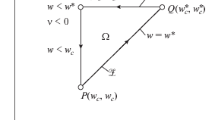Abstract
Intense beams of charged particles serve as a working element in electrophysical devices for a wide range of scientific and practical applications. Mathematical modeling of intense beams leads to the solution of a self-consistent nonlinear problem, which includes the calculation of electric and magnetic fields, trajectories of charged particles, and space charge. An extended electron-optical system is understood as an electron-optical system whose size in the direction of the beam’s motion is much larger than the transverse size. The use of traditional computational approaches to modeling such systems did not give satisfactory results. In this paper, we propose new algorithms and technologies aimed at improving their accuracy and reducing the calculation time. They are based on computational domain decomposition methods and are as follows. First, the extended computational domain is divided into two subdomains: in the first subdomain, an intense beam is formed, and in the second subdomain, it is additionally accelerated and transported. The solutions are “stitched” by the alternating Schwarz method. Second, in each of these subdomains, an adaptive quasi-structured locally modified grid is constructed, consisting of structured subgrids. The proposed quasi-structured grid can significantly reduce labor costs when calculating the trajectories of charged particles. Third, on the emitter, the singularity is isolated by introducing a near-emitter subdomain. In this subdomain, an approximate analytical solution is constructed, which is stitched with the numerical solution in the main subdomain in the iterative Broyden process. On the example of a model problem about a flat diode, the fast convergence of the Broyden method is shown. With the help of the proposed algorithms and technologies, the results of modeling a complex practical system are obtained, which closely match the results of natural experiments.





Similar content being viewed by others
REFERENCES
V. A. Syrovoi, Introduction to the Theory of Intense Charged-Particle Beams (Energoatomizdat, Moscow, 2004) [in Russian].
V. A. Syrovoi, Theory of Intense Charged-Particle Beams (Energoatomizdat, Moscow, 2004) [in Russian].
V. P. Il’in, Numerical Methods for Solving Electro-Optics Problems (Nauka, Novosibirsk, 1974) [in Russian].
S. I. Molokovskii and A. D. Sushkov, Intense Electron and Ion Beams (Energoatomizdat, Moscow, 1991) [in Russian].
I. V. Alyamoskii, Electron Beams and Electron Guns (Sov. Radio, Moscow, 1966) [in Russian].
D. A. Ovsyannikov, I. D. Rubtsova, and V. A. Kozynchenko, Some Problems of Modeling Intense Charged-Particle Beams in Linear Accelerators (Izd. VVM, St. Petersburg, 2013) [in Russian].
E. Munro, “Numerical simulation methods for electron and ion optics,” Nucl. Instrum. Methods Phys. Res. A 645 (1), 266–272 (2011). https://doi.org/10.1016/j.nima.2010.11.181
V. Dolean, P. Jolivet, and F. Nataf, An Introduction to Domain Decomposition Methods: Algorithms, Theory, and Parallel Implementation (SIAM, Philadelphia, PA, 2015).
A. Quarteroni and A. Valli, Domain Decomposition Methods for Partial Differential Equations (Clarendon Press, Oxford, 1999).
Yu. V. Vasilevskii and M. A. Olshanskii, A Short Course on Multigrid and Domain Decomposition Methods (MAKS Press, Moscow, 2007) [in Russian].
A. V. Skvortsov, “A survey of algorithms for constructing a Delaunay triangulation,” Vychisl. Metody Program. 3 (1), 18–43 (2002).
A. N. Kozyrev and V. M. Sveshnikov, “On the construction of two-dimensional local-modified quasistructured grids and solving on them two-dimensional boundary value problems in the domains with curvilinear boundary,” Vestn. Yuzhno-Ural. Gos. Univ., Ser.: Vychisl. Mat. Inf. 6 (2), 5–21 (2017). https://doi.org/10.14529/cmse170201
V. P. Il’in, Methods and Technologies of Finite Elements (IVMiMG Sib. Otd. Ross. Akad. Nauk, Novosibirsk, 2007) [in Russian].
J. Saad and M. H. Schultz, “GMRES: a generalized minimal residual algorithm for solving nonsymmetric linear systems,” SIAM J. Sci. Stat. Comput. 7 (3), 856–869 (1986). https://doi.org/10.1137/0907058
S. K. Godunov. Equations of Mathematical Physics (Nauka, Moscow, 1979) [in Russian].
P. I. Akimov, G. P. Osipova, and V. A. Syrovoi, “Problems in increasing the accuracy of programs for analysing the trajectories of intense electron beams,” USSR Comput. Math. Math. Phys. 29 (2), 54–66 (1989). https://doi.org/10.1016/0041-5553(89)90008-6
V. M. Sveshnikov, “Calculation of the intensive charged particle beams with increased accuracy,” Proc. SPIE 5398, 34–50 (2004). https://doi.org/10.1117/12.551796
J. E. Dennis and R. B. Schnabel, Numerical Methods for Unconstrained Optimization and Nonlinear Equations (Prentice-Hall, Englewood Cliffs, NJ, 1983).
V. T. Astrelin, M. S. Vorobyov, A. N. Kozyrev, and V. M. Sveshnikov, “Numerical simulation of the operation of a wide-aperture electron gun with a grid plasma emitter and beam output into the atmosphere,” J. Appl. Mech. Tech. Phys. 60 (5), 785–792 (2019). https://doi.org/10.1134/S0021894419050018
Author information
Authors and Affiliations
Corresponding author
Ethics declarations
The authors declare that they have no conflicts of interest.
Rights and permissions
About this article
Cite this article
Kozyrev, A.N., Sveshnikov, V.M. Mathematical Modeling of Intense Beams of Charged Particles in Extended Electron-Optical Systems. Math Models Comput Simul 14, 799–807 (2022). https://doi.org/10.1134/S2070048222050076
Received:
Revised:
Accepted:
Published:
Issue Date:
DOI: https://doi.org/10.1134/S2070048222050076




